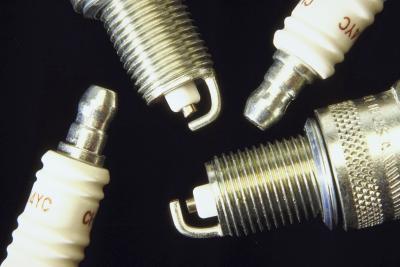
Automobile vehicles use spark plugs to ignite the air-fuel mixture inside the cylinder for the purpose of combustion. A spark plug has a relatively simple construction and is nearly maintenance-free, except for the adjustment (gap) of its electrode and periodic cleaning or replacement. Setting the gap on the spark plug electrode determines the voltage length and duration of the spark. A spark plug that has an improper gap will show certain signs and symptoms.
The basic construction of a spark plug uses an upper contact tip that receives voltage from the ignition system through a spark plug wire. The tip continues down as the center electrode through an insulated core composed of a ceramic housing, usually made of porcelain. The spark plug also has a steel jacket, which allows the threaded end of the plug to be torqued into the cylinder head. The center electrode ends in a gold or palladium nipple-like tip. A copper core ground electrode that serves as a ground strap, either straight or tapered, arches over the tip to provide a gap. A high voltage spark jumps the gap, producing ignition fire.
Spark plug specifications, which include type, heat range and gap, will be found in the owner's repair manual. Heat range indicates the length of time needed for heat to be drawn away from the plug tip. The gap, the distance between the "Hot" and "Ground" electrode points, is set and listed by the manufacturer for optimum performance. The gap measurement will be indicated in thousandths of a inch. For example, a typical plug gap is 0.035, or thirty-five thousandths of an inch. Spark plugs generally produce 10,000 to 30,000 volts of arc between the electrode points.
Several tools are available to gap spark plugs. Feeler gauge blades, sliding bevel, wire type and pliers tools exist to gauge and set the distance between the electrode contact points. Reducing the spark plug gap is accomplished by tapping down the outer ground electrode with a small hammering tool, or prying it open with a thin blade, so that an accurate gap can be set with a spark plug tool.
When the spark plug gap is too narrow, or under specifications, the amount of room needed for the air-fuel mixture between the hot tip and the ground strap is decreased. The duration of the spark has less travel distance, thus not remaining hot enough with sufficient charge to ignite the air-fuel mixture. The symptoms of narrow gap include a noticeable (continuous) cylinder miss, hard starting if all the plugs have narrow gaps, rough idle and engine hesitation. A spark plug that does not fire, resulting from a narrow gap, will appear black or wet when inspected. The black or wet appearance indicates unburned fuel.
Excessive spark plug gap results when the voltage has too far to travel. The increased length of the spark travel weakens it, robbing it of the hot, strong ignition charge it needs to fire the plug. Excessive plug gap also results in cylinder misfiring, a possible no-start condition, wet, black or fouled plugs, engine hesitation and rough idle. Excessive spark plug gap also happens as result of normal electrode wear and age.
Some of the newer, high-performance spark plugs, like the Champion E3, have modified ground straps that produce multiple spark pathways that ensure even fire all around the firing tip. These types of spark plugs cannot be adjusted.